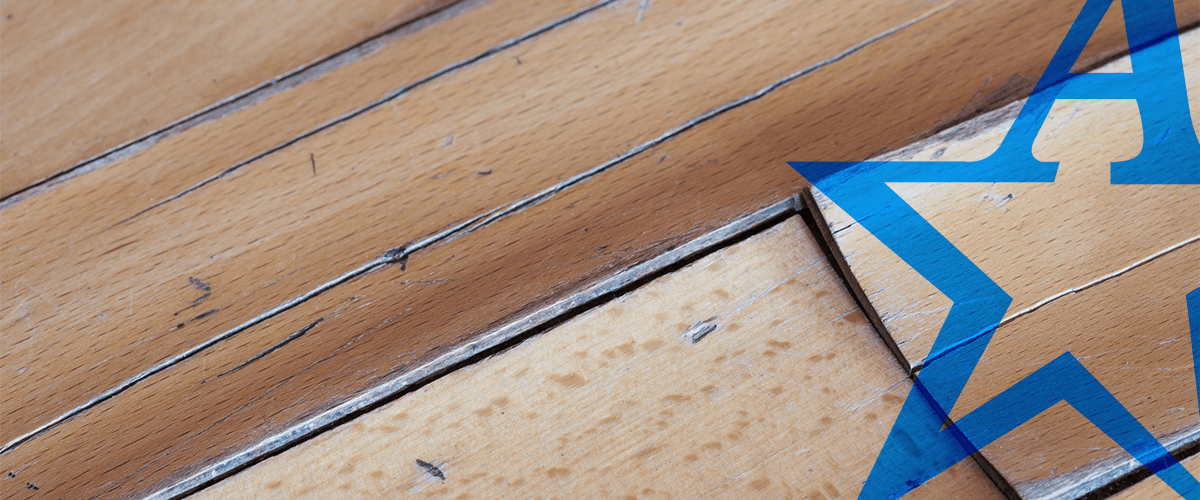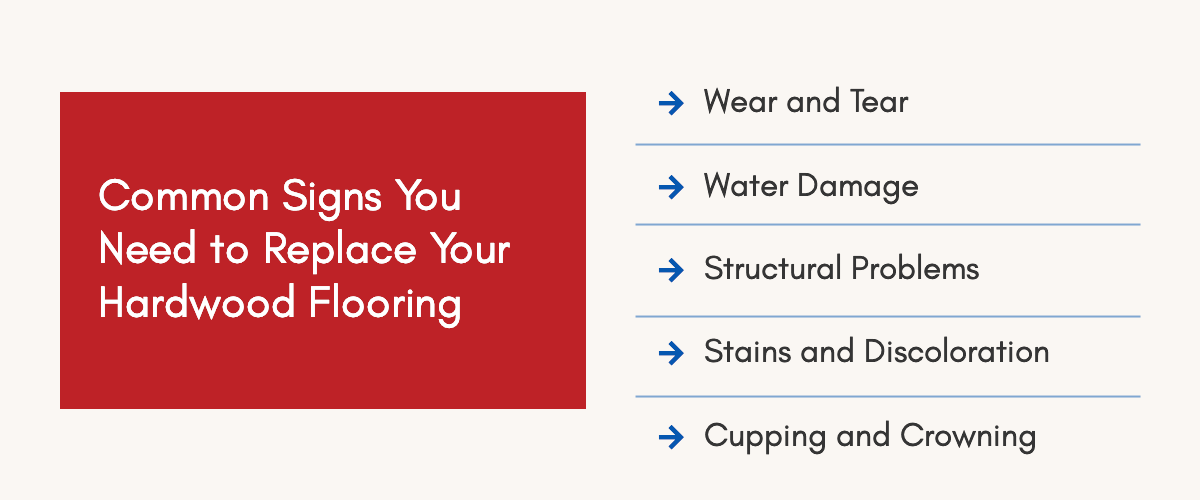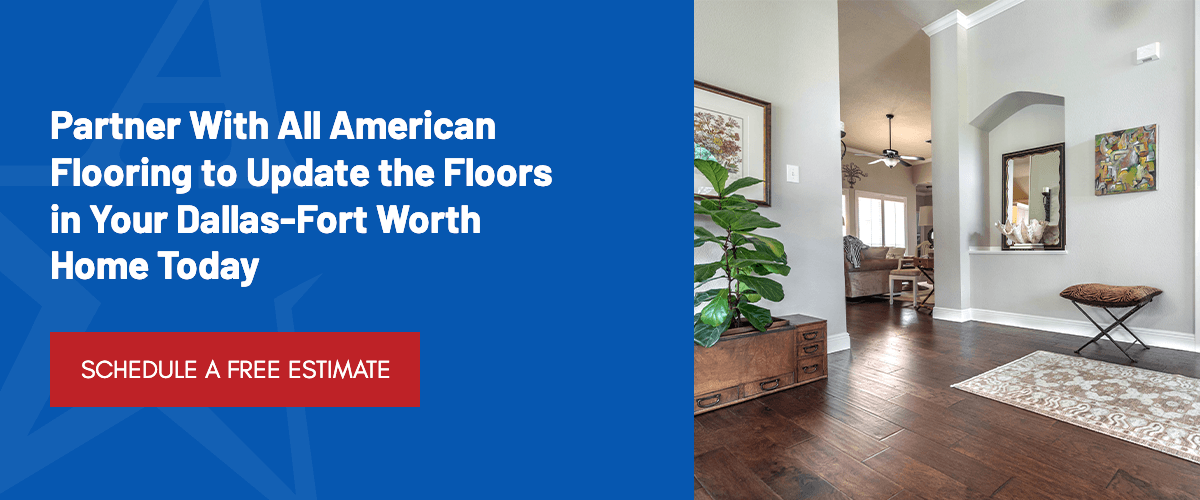Signs It’s Time to Replace Your Hardwood Floor

Table of Contents
Hardwood floors are highly popular for their warm, classic appearance and robust strength. However, they may need updating to maintain their beauty and integrity. Knowing when to replace or refinish your hardwood flooring can help you achieve a safer, better-looking space that you’re proud to show your guests.
Below, we are sharing some indications your flooring could use an update and the primary considerations for choosing the perfect floors for your unique style.
Common Signs You Need to Replace Your Hardwood Flooring
While hardwood flooring is one of the longest-lasting and most durable options on the market, it does require updating now and then. A few telltale signs can help you determine when you should replace the hardwood in your home.

Wear and Tear
General surface damage is a good indication that your flooring needs updating. Scratches, gouges and dents can accumulate over time, impacting the look and feel of the wood. Serious imperfections can affect how furniture sits on the ground. Dullness and thinning may also occur from heavy use, especially in areas throughout the home that endure regular foot traffic.
If you notice widespread wear and tear, you may need to replace your hardwood floors.
Water Damage
Water damage is a significant concern for hardwood because it can compromise the integrity of your floors. Exposure to too much moisture can cause swelling, warping and buckling, impacting the safety and aesthetics of your space.
Another potential complication is mold and mildew growth, which can harm your health if left untreated. Water can cause rotting over time and weaken the floor’s wood fibers. Signs of rot include musty smells, spongey or soft spots and discoloration. Investing in water-resistant hardwood is always best for combatting potential damage and supporting your flooring’s durability and longevity.
Structural Problems
If you’re dealing with structural issues, including sagging, bounciness, unevenness or loose boards, your hardwood flooring needs to be replaced. If ignored, these problems can lead to further damage and pose serious tripping and safety hazards in your home.
Gaps and cracks between the boards are another key indicator of compromised structural integrity. Listen for creaking floorboards as you walk. These sounds can suggest problems with the subfloor and joists.
Stains and Discoloration
Hardwood floors can become discolored over time from spills, chemical cleaning agents or pet accidents. While you may be able to remove some stains, persistent and deep-seated ones can create an eyesore on your flooring.
Sun exposure can cause discoloration and prematurely age the wood planks, impacting the floor’s overall appearance and aesthetics. When you can no longer maintain the beauty of your hardwood flooring, it is likely time to replace it.
Cupping and Crowning
Another key indication your hardwood flooring requires updating is if the planks are cupping or crowning. Cupping occurs when a plank’s center is lower than its edges, usually from excess moisture. Crowning occurs when the plank’s center is higher than its edges from excessive drying.
Fluctuating humidity, water leaks, changing temperatures or poor installation can cause the floorboards to warp in different directions. Severe cupping and crowning can make your hardwood floors unstable and unsightly.
Assessing the Life Span of Your Hardwood Floors
Hardwood flooring is known for its longevity. The life span of 100% hardwood can range from 30 to 100 years, while engineered hardwood can last about 30 years if homeowners care for it properly.
Key factors that contribute to your hardwood flooring’s life span include:
- Wood species: Different types of wood vary in durability and strength. For instance, cherry or birch is softer and best for low-traffic areas in the home. Hickory and oak are harder and work well in areas that your family frequents.
- Maintenance: Regular cleaning, resealing and refinishing can help your hardwood floors maintain their good looks and last longer.
- Environmental conditions: The humid climate in Texas can impact hardwood flooring longevity. Consistent, dry indoor conditions will help preserve the wood’s integrity and appearance.
- Foot traffic: Another factor impacting hardwood life spans is use. Areas with a lot of foot traffic are likely to wear out sooner.
- Pets, kids and furniture: Your household can directly impact hardwood longevity. Kid’s toys, heavy furniture and pet claws can damage the floor surface.
Refinishing vs. Replacing
A huge advantage of having hardwood flooring in your home is restoring its quality through refinishing. You can remove the floor’s existing varnish before resealing and restaining it to make it look new again if you’re dealing with minor surface damage, like light wear or scratches.
However, updating the hardwood may be necessary if you’re dealing with serious structural damage or cosmetic issues or if you’re interested in updating the wood species.
On average, replacing your hardwood flooring costs about two to three times more than refinishing, but updating the floors will increase the value of your home more significantly.
Determining Whether Your Hardwood Floors Are Worth Saving
The best way to determine if your old hardwood flooring is worth saving or refinishing is by working with an experienced flooring expert. They can assess the quality and condition of the wood.
An expert may be able to share the potential return on investment for refinishing versus replacing your flooring to help you gauge the best decision for your home and budget limitations.
Considerations for Choosing New Hardwood Flooring
When replacing the hardwood floors in your home, the following considerations can help you make the right choice:
- Budget: Determine how much you’re willing to spend on materials and installation. Your budget will inform the type of wood and finish you’ll select.
- Flooring type: Consider whether you’re interested in investing in 100% hardwood or engineered hardwood. The former is longer-lasting but comes with a higher price tag and is not best for areas exposed to moisture. Engineered hardwood is more cost-effective and can work well in spaces with fluctuating humidity levels, but it has a shorter life span.
- Style: Your interior design preferences are important to remember when selecting a wood species, grain pattern, color and finish for your new hardwood floors. You can work with an expert to determine the best style for your specific space.
Partner With All American Flooring to Update the Floors in Your Dallas-Fort Worth Home Today
If you’re ready to replace the hardwood flooring in your Dallas-Fort Worth home, turn to the professionals at All American Flooring. We have more than three decades of experience helping homeowners in the DFW metroplex source quality flooring that suits their family’s needs and aesthetic preferences. Our team of experts offers top-tier installation services and can help you find budget-friendly, low-maintenance flooring that lasts for years to come.
Schedule a free in-home estimate from All American Flooring.



